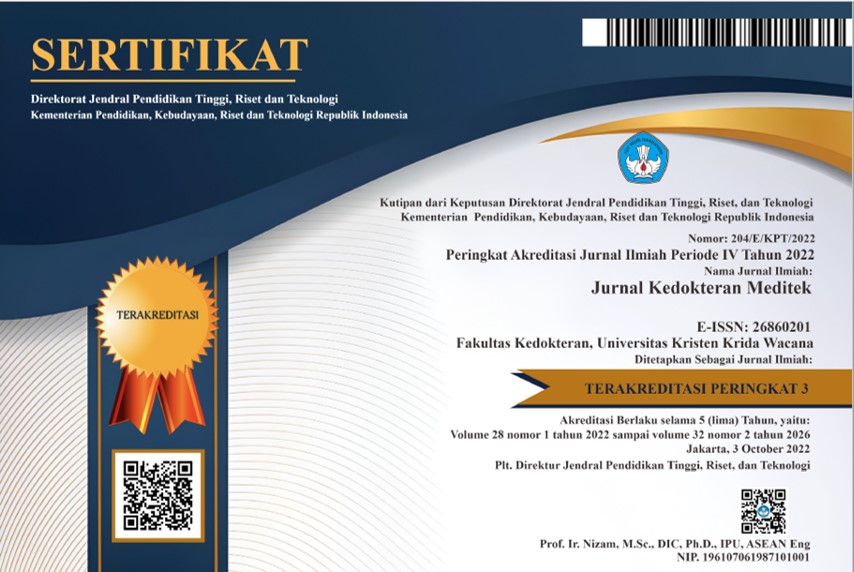Hyperuricemia of The Pregnancy and Gestasional Diabetes
DOI:
https://doi.org/10.36452/jkdoktmeditek.v25i3.1776Keywords:
Hyperuricemia, Gestational DM, type 2 Diabetes Mellitus.Abstract
This review aims to determine the metabolic effect of hyperuricemia in pregnant woman, especially those with gestational diabetes mellitus (GDM). In women, the serum uric acid level is lower compared to men of similar age. The value is related to higher estrogen concentration to increase uric acid clearance. Hyperuricemia already established as independent risk factors for metabolic syndrome and cardiovascular disease (CVD) as well as type 2 Diabetes Mellitus (DM). Asymptomatic hyperuricemia in non-pregnant adult women will increase insulin resistance due to oxidative stress, and production of inflammatory cytokine (tumor necrosis factor-a), which inevitably increases blood sugar level. Uric acid level and serum creatinine is lower in normal pregnancy due to increased renal clearance and the uricosuric effect of estrogen. Hyperuricemia is one of the contributing factors associated with insulin resistance among pregnancy instead direct effect of placental hormones. Earlier in the first trimester of pregnancy, the risk for GDM is increased. However, the causal effect of uric acid levels on DM still requires further study .
References
2. Mandell B. Clinical manifestations of hyperuricemia and gout. 2008. Epub ahead of print 1 August 2008. DOI: 10.3949/ccjm.75.Suppl_5.S5.
3. Maiuolo J, Oppedisano F, Gratteri S, et al. Regulation of uric acid metabolism and excretion. Int J Cardio.l 2016;213: 8–14.
4. Mohan J, Suriyamoorthi J, Menon M. Correlation of raised serum uric acid in first trimester of pregnancy and the risk of gestational diabetes: a prospective study. Int J Reprod Contraception, Obstet Gynecol. 2017; 6(8). Epub ahead of print 2017. DOI: 10.18203/2320-1770.ijrcog20173499.
5. Dincer E, P Dincer A, Levinson D. Asymptomatic hyperuricemia: To treat or not to treat. 2002. Epub ahead of print 1 September 2002. DOI: 10.3949/ccjm.69.8.594.
6. Wei C-Y, Sun C-C, Wei JC-C, et al. Association between hyperuricemia and metabolic syndrome: An epidemiological study of a labor force population in Taiwan. Biomed Res Int. 2015: 369179.
7. Kodama S, Saito K, Yachi Y, et al. Association between serum uric acid and development of type 2 diabetes. Diabetes Care. 2009;32: 1737–42.
8. Kushiyama A. Linking uric acid metabolism to diabetic complications. World J Diabetes. 2014;5: 787.
9. Choi BG, Jin Kim D, Jong Baek M, et al. Hyperuricemia and development of type 2 diabetes mellitus in asian population. Clin Exp Pharmacol Physiol; 45. Epub ahead of print 20 December 2017. DOI: 10.1111/1440-1681.12911.
10. Perez-Ruiz F, Dalbeth N, Bardin T. A review of uric acid, crystal deposition disease, and gout. Adv Ther. 2015;32: 31–41.
11. Pleskačová A, Bartakova V, Chalasova K, et al. Uric acid and xanthine levels in pregnancy complicated by gestational diabetes mellitus—the effect on adverse pregnancy outcomes. Int J Mol Sci. 2018;19: 3696.
12. Barbieri L, Verdoia M, Schaffer A, et al. Impact of sex on uric acid levels and its relationship with the extent of coronary artery disease: A single-centre study. Atherosclerosis. 2015;241: 241–8.
13. Dehghan A, van Hoek M, Sijbrands EJG, et al. High serum uric acid as a novel risk factor for type 2 diabetes. Diabetes Care. 2008;31: 361–2.
14. Laughon SK, Catov J, Provins T, et al. Elevated first-trimester uric acid concentrations are associated with the development of gestational diabetes. Am J Obstet Gynecol. 2009;201: 402.e1-402.e4025.
15. Weisz B, Cohen O, Homko CJ, et al. Elevated serum uric acid levels in gestational hypertension are correlated with insulin resistance. Amer J Perinatol. 2005;22: 139–44.
16. Johnson RJ, Kanbay M, Kang D-H, et al. Uric acid: a clinically useful marker to distinguish preeclampsia from gestational hypertension. Hypertens (Dallas, Tex 1979) 2011;58:548–9.
17. Amini E, Sheikh M, Hantoushzadeh S, et al. Maternal hyperuricemia in normotensive singleton pregnancy, a prenatal finding with continuous perinatal and postnatal effects, a prospective cohort study. BMC Pregnancy Childbirth. 2014;14: 104.
18. Bainbridge SA, von Versen-Höynck F, Roberts JM. Uric acid inhibits placental system A amino acid uptake. Placenta. 2009; 30: 195–200.
19. Bainbridge SA, Roberts JM, von Versen-Höynck F, et al. Uric acid attenuates trophoblast invasion and integration into endothelial cell monolayers. Am J Physiol Physiol. 2009;297: C440–50.
20. Barbour LA, McCurdy CE, Hernandez TL, et al. Cellular mechanisms for insulin resistance in normal pregnancy and gestational diabetes. Diabetes Care. 2007;30: S112 LP-9.
21. Dahlgren J. Pregnancy and insulin resistance. Metab Syndr Relat Disord. 2006;4: 149–52.
22. Fawzy M, Mohamed M, Hassanin A, et al. The association between hyperuricemia in first trimester and the development of gestational diabetes. Journal of Fertilization: In Vitro-IVF-Worldwide, Reproductive Medicine, Genetics & Stem Cell Biology 2017;5: 1–8.
23. Chauhan M, Tomar S. A clinical study analyze serum uric acid as risk factor for gestational diabetes mellitus. JMSCR. 2016;04: 12980–3.
24. Ganta SJ, Kulkarni SR. First trimester uric acid level : a reliable marker for gestational diabetes mellitus. Int J Reprod Contracept Obs Gynecol. 2019;8: 2358–62.
25. El-gharib MN, Mahfouz AE, Morad MA, et al. Prediction of gestational diabetes by measuring first trimester maternal serum uric acid concentration. J Basic Clin Reprod Sci. 2013;2: 27–31.
26. Hassan NAABO, Rezk AY, Salama KM, et al. Early detection of gestational diabetes via measurement of first trimester maternal serum uric acid. Med J Cairo Univ. 2016; 84: 151–8.
27. Rasika C, Samal S, Ghose S. Association of elevated first trimester serum uric acid levels with development of GDM. J Clin Diagnostic Res. 2014;8: OC01–5.

















